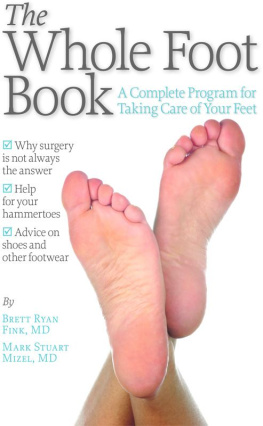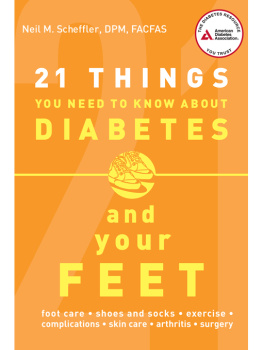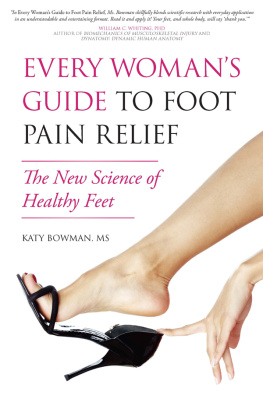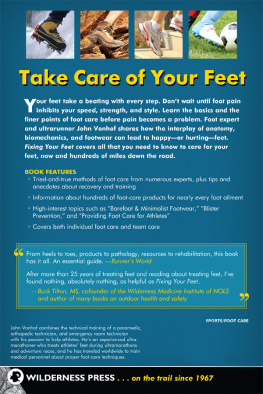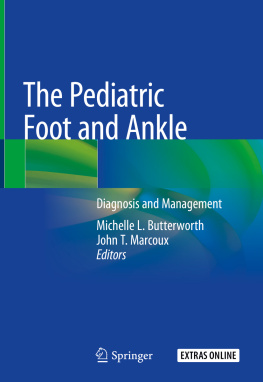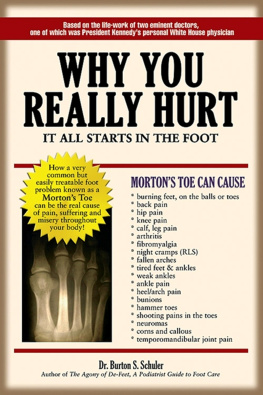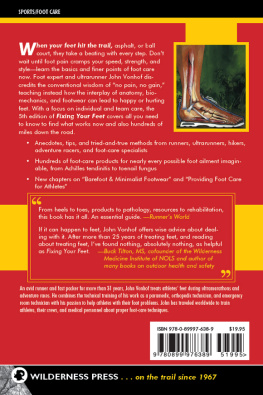The Whole Foot
A Complete Program for Taking Care of Your Feet
The Whole Foot
A Complete Program for Taking Care of Your Feet
Brett R. Fink, MD
Mark S. Mizel, MD

ISBN: 978-1-936303-24-3
eISBN: 978-1-617050-96-1
Acquisitions Editor: Noreen Henson
Production Editor: Michael Lisk
Compositor: Newgen
Printer: Hamilton Printing
Visit our web site at www.demoshealth.com
2012 Brett R. Fink and Mark S. Mizel. All rights reserved. This book is protected by copyright. No part of it may be reproduced, stored in a retrieval system, or transmitted in any form or by any means, electronic, mechanical, photocopying, recording, or otherwise, without the prior written permission of the publisher.
Medical information provided by Demos Health, in the absence of A visit with health care professional, must be considered as an educational service only. This book is not designed to replace a physicians independent judgment about the appropriateness or risks of a procedure or therapy for given patient. Our purpose is to provide you with information that will help you make your own health care decisions.
The information and opinions provided here are believed to be accurate and sound, based on the best judgment available to the authors, editors, and publisher, but readers who fail to consult appropriate health authorities assume the risk of any injuries. The publisher is not responsible for errors or omissions. The editors and publisher welcome any reader to report to the publisher any discrepancies or inaccuracies noticed.
CIP data is available from the Library of Congress
Special discounts on bulk quantities of Demos Health books are available to corporations, professional associations, pharmaceutical companies, health care organizations, and other qualifying groups. For details, please contact:
Special Sales Department
Demos Medical Publishing
11 W. 42nd Street
New York, NY 10036
Phone: 800-532-8663 or 212-683-0072
Fax: 212-941-7842
E-mail: rsantana@demosmedpub.com
Made in the United States of America.
11 12 13 14 5 4 3 2 1
To my wife, Patricia, and daughters, Alexis and Laurel, who
love me despite my faults. To my patients and colleagues at
Indiana Orthopedic Center and Community and Hancock
Hospitals who continue to teach and inspire me.
BRF
To my father, Harold H. Mizel, who urged me to pursue excellence.
MSM

Contributors
Brett R. Fink, MD, FAAOS, FAOFAS
Orthopedic Surgeon
President, Indiana Orthopedic Center
Indianapolis, IN
Cameron Gabrielson, MD, FACS, CWS, FACCWS
General Surgeon
Medical Director, Hancock Center for Wound Healing
Greenfield, IN
Keon Mansoori, JD, CO
Orthotist
Advanced Orthopro, Inc.
Indianapolis, IN
Ginat W. Mirowski, DMD, MD
Dermatologist in Private Practice and
Adjunct Associate Professor, Indiana University School of Dentistry
Indianapolis, IN
Mark S. Mizel, MD, FAAOS, FAOFAS
Orthopedic Surgeon
Professor, University of Miami, Retired
Boston, MA
Celia M. Ristow
Haverford College
Haverford, PA

Introduction
T he foot is a wonderful and amazing organ. It contains 28 bones, 31 joints, countless ligaments, tendons, and muscles, all working in concert to allow us to run, balance, twist, turn, and jump. The foot is seemingly impossibly complex and small, but it performs a huge variety of high-stress activities throughout our long lifespanfrom the endless pounding of running a marathon runner to the disciplined balance of a ballerina en pointe, the foot is capable of grace and resilience. It can walk on soil, asphalt, and rock without significant difficulty. Even through the more mundane tasks of the daily walking, lifting, and adjusting to a wide array of terrain, feet perform reliably.
Unfortunately, there are also an endless number of ways that the foot can develop problems. When the foot malfunctions, pain is often felt with every step. The pain can severely limit our ability to work, parent, and perform daily activities. Recreational activities that made life enjoyable can become intolerable. These problems can become disabling.
Diagnosis and treatment of these problems can also be confusing and frightening for the people that have them. Often the structures involved are not the ones covered in high school biology. The mechanisms that lead to foot problems are also complicated and unclear, but the foot is mechanical device and can be understood by using the same mechanical principles that can be seen all around us. A clear understanding of the mechanics of the foot can help us to design methods of treatment.
Surprisingly, foot problems are often not understood by some of the very physicians that we go to in search of help. When graduating from medical school, the new doctor is fully capable of diagnosing heart attacks and diabetes. It is surprising how little time is devoted to musculoskeletal problems in generaland foot problems specificallyin most medical programs. Musculoskeletal problems are also not given high priority during a routine checkup when time is limited. The explanations and treatment strategies are often not well thought out or completely satisfactory.
A clear understanding of a foot problem is helpful not only in reducing the anxiety associated with a painful condition, but also in understanding the goals and methods of the treatment. Medical treatment should be an alliance between you and your physician. Without a clear understanding of the goal and rationale behind a treatment, it is difficult for anyone to completely invest themselves in a rehabilitation and treatment program. If there is no enthusiasm for the treatment, the program will likely be ineffective. Vague instructions are difficult to follow and lead to failure of the treatment.
WHY THIS BOOK?
Few people can retain more than one or two things that are told to them at any one sitting. It is not that they lack intelligence, but it is difficult in a 5- or 10-minute discussion to learn a whole topic that is largely unfamiliar to anything that you have learned previously. Learning is most effective when the information can be built on a foundation of basic understanding. We would have the same difficulty with remembering facts if someone tried to help us learn electrical engineering or to speak Arabic in fifteen minutes. We would forget much of what we had learned or heard immediately and remember even less of the information several hours or days later. The main goal of this book is to build this foundation of information.
One would think that the Internet would settle all of this confusion. People are more informed than they have been in the past. Whether this means that they are better informed is debatable. Although there are many good references on the Internet, there is also a lot of unproven, inaccurate, and, sometimes dangerous information. Place any medical diagnosis in a search engine on the Internet and you will get a number of hits most likely in the millions. Few determined online researchers have the patience to comb through more than the first few pages of the results of any Internet search. Many of the web sites have paid for the privilege of being within that first few pages. Most of the sites have some financial interest in selling you somethinga new medication, procedure, or a device. Although these things may have some reasonable use, often the claims made are unsubstantiated by any reliable scientific study and dont work. It is important to establish the effectiveness of any form of treatment to establish the risks and benefits so that we can determine whether using it is worth the risk, inconvenience, and expense. We have seen many treatments and devices come in and out of fashion like the latest clothing style as initial enthusiasm is replaced by a sobering and disappointing realization of the problems and practical real-life results of a technique. It is clear that treatments that have not stood the test of time and careful scientific method should be approached with caution.
Next page
